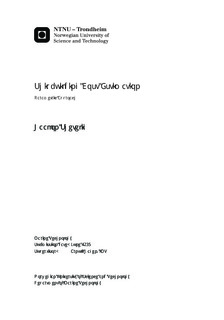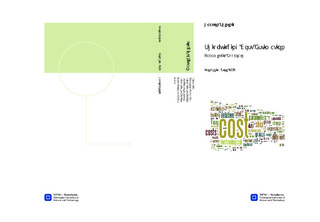| dc.contributor.advisor | Hagen, Arnulf | nb_NO |
| dc.contributor.author | Shetelig, Haakon | nb_NO |
| dc.date.accessioned | 2014-12-19T12:10:00Z | |
| dc.date.available | 2014-12-19T12:10:00Z | |
| dc.date.created | 2013-09-19 | nb_NO |
| dc.date.issued | 2013 | nb_NO |
| dc.identifier | 649603 | nb_NO |
| dc.identifier | ntnudaim:9719 | nb_NO |
| dc.identifier.uri | http://hdl.handle.net/11250/238624 | |
| dc.description.abstract | A continuously increasing global competition in the ship building industry leads to decreasing margins and an increased cost pressure for Norwegian shipbuilders. The Norwegian ship designers and shipbuilders are known throughout the world for delivering complex vessel with high quality, on time. Shipowners have so far been willing to pay the price for Norwegian offshore support vessels. However, high quality products will at some point be outcompeted by less expensive solutions.An effective cost estimation framework can contribute to a competitive advantage. This thesis presents a methodology for developing a cost estimation framework to identify, investigate and evaluate the importance and behavior of cost drivers in offshore shipbuilding. The outcome of the method is cost estimating relationships (CER) that express the relative consequences on the total cost due to relative changes of high level performance requirements. These CERs is called relative change-CERs. A relative change-CER could for example express the relative consequence on the total cost due to a 5 % increase of the installed engine power.The method can be characterized as a parametric top-down cost estimation approach. By using historical cost data and specifications for a population of vessels of a certain ship type, it is possible to find relationships between important performance parameters and costs. With regression techniques, CERs expressing unit costs per cost driving parameter for different technological groups of the vessel can be found. By using these unit cost-CERs on already existing vessels and then theoretically change the ship?s performance parameters, one will see the theoretical consequence on the total cost. By changing a chosen cost driving parameter with different intervals for several vessels, the average relative consequences on the total cost is found for that ship type. The relative change-CERs can be utilized differently by actors in the shipbuilding industry. One area of application is in the negotiation process with a potential customer where features like ship specifications and change orders are discussed. The relative change-CERs contribute to leverage for the yard personnel?s arguments, and reduce the response time for rebids and tender requests.Another area of application for the relative change-CERs is for gaining insight of the behavior of important cost drivers in offshore ship building. With a set of unit cost curves and relative change-CERs, it is possible to identify how the different parts of the ship are affected by a relative change in certain ship parameters. This information can be used to rank the different ship parameters according to their importance and relative influence on the total ship building cost. | nb_NO |
| dc.language | eng | nb_NO |
| dc.publisher | Institutt for marin teknikk | nb_NO |
| dc.title | Shipbuilding Cost Estimation: Parametric Approach | nb_NO |
| dc.type | Master thesis | nb_NO |
| dc.source.pagenumber | 59 | nb_NO |
| dc.contributor.department | Norges teknisk-naturvitenskapelige universitet, Fakultet for ingeniørvitenskap og teknologi, Institutt for marin teknikk | nb_NO |

